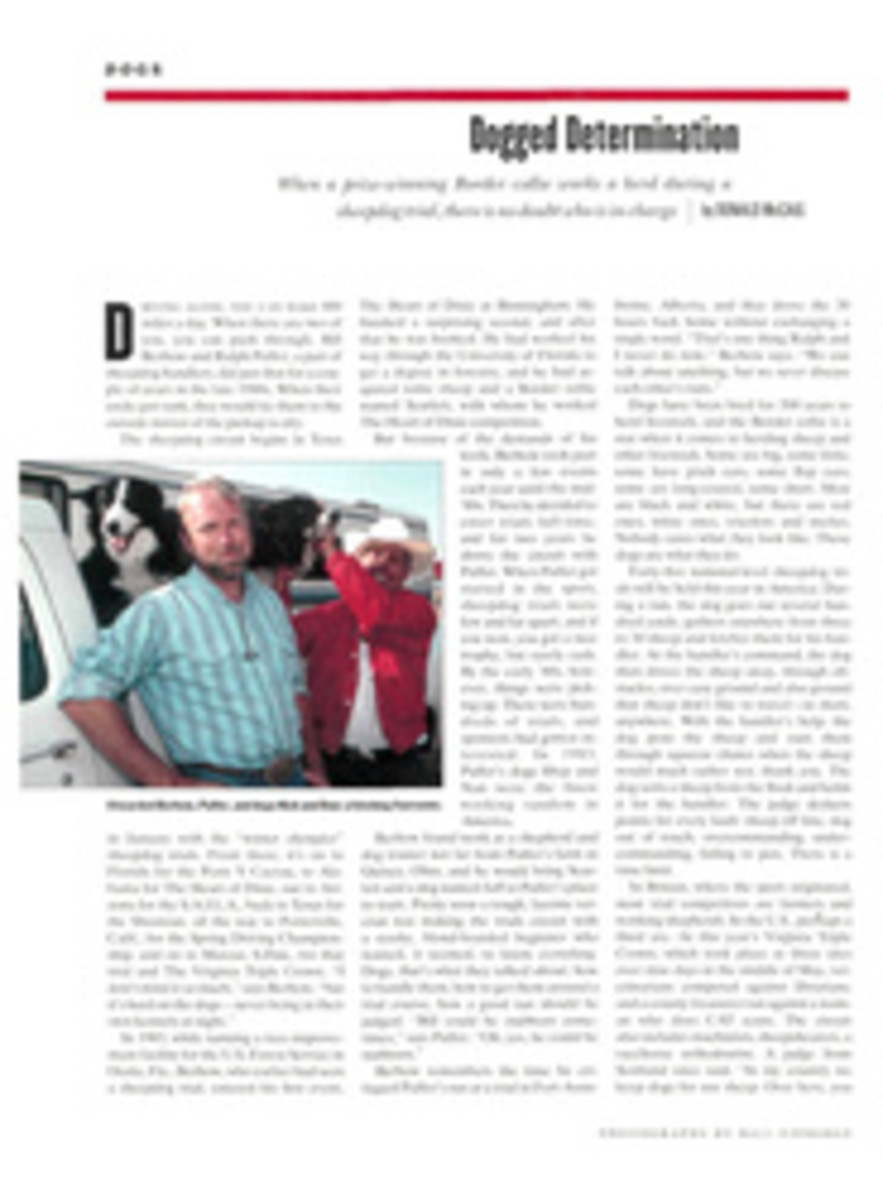
They Like Plane Living
At first glance, Spruce Creek looks like many Sun Belt retirement neighborhoods. One finds the requisite golf course, tennis courts and streets with names like Country Club and Seclusion Drive. But Spruce Creek, a community of 1,300 residents near Daytona Beach, is different. A typical real estate listing might read something like this: 3 bdrms, 2 bths, 2-car grg, 2-pln hngr, 1 txwy, $300,000.
People are plane crazy here. About half of the houses have a driveway out front and a taxiway out back. Spruce Creek boasts 13 miles of paved taxiway linking private hangars to the community's runway, which was built in 1943 as a Naval Air training site. Year-round residents include 35 commercial airline pilots, some of whom commute to their jumbo jets in their single-engine prop planes. Then, too, there's actor John Travolta, an avid flyer since he was 16. Travolta owns a World War II De Havilland Vampire fighter jet, which he flies for sport, and a six-passenger Lear 24B, which he pilots to film locations.
"The planes sometimes cost more than the houses," says Bobbie Scallan, a sales representative for Spruce Creek Properties, Inc., and a Spruce Creek resident. "We have different priorities here."
It's Saturday morning in Spruce Creek, and Bobbie and her husband, Joe, who's a pilot, have joined Paul and Mary Lowe aboard the Lowes' six-passenger Piper Malibu. Paul, a retired producer of TV commercials and a confessed gadget freak, has recently added about a hundred thousand dollars' worth of state-of-the-art avionics, including a storm scope and a collision-avoidance system, to his plane. Paul steers the Malibu left onto Taxiway Lindy Loop, one of three Spruce Creek thoroughfares that accommodate both aircraft and automobile traffic. He heads toward the airport's 4,000-foot runway. "I don't fly unless I have an excuse," says Lowe as he taxis the plane. "But it doesn't take much of an excuse." Today's excuse: breakfast in Ocala, 62.1 nautical miles to the west.
When he lands, he parks alongside a couple of Piper Arrows, a V-tailed Bonanza and a Cessna Cardinal RG, in a grouping of 10 planes, all belonging to fellow members of the Spruce Creek Flying Club. The club has designated Ocala as today's weekly breakfast fly-out destination. The tiny Ocala Municipal Airport restaurant, which has been reserved in advance by the flying club, smells of omelets, bacon and coffee. As the airfolk enjoy their fly-out meal, they talk of future flights. Someone mentions the approaching weekend fly-out to New Orleans. Everyone seems enthusiastic about it. These people seem enthusiastic about any topic that comes up, as long as it has to do with air travel. The Spruce Creekers take their last sips of coffee.
The schmoozing continues out on the tarmac. It dissipates only when the travelers head back to their planes. They board and slowly form a moving queue of aircraft awaiting takeoff. Finally, everyone is headed home. The passengers gaze down upon the dusty brown thoroughbred racetracks that dot the green pastures of central Florida. What a fine breakfast.
On the return flight, Lowe detours and flies over Leeward Air Ranch, another fly-in community, which features 80 homes with hangars. A dozen of these rather odd living units line the west side of a 6,200-foot grass airstrip. Leeward is just as air-addicted as Spruce Creek; 1-800-LIV-2FLY is the phone number and prevailing spirit of the Leeward development agency. The community has a pilots-only home sales policy.
There are 500 or so hangar-home communities in the U.S., according to Dave Sclair, president of the Tacoma-based Living With Your Plane Association and editor and publisher of General Aviation News and Flyer, a biweekly tabloid. "I think the demand for fly-in living is on the increase," says Sclair. "A lot of public airports have become so crowded, and hangar rents now sometimes go for $400, $600, even $1,000 a month-if you can find them. Plus, it's a life-style thing. People who fly tend to be more independent-minded and like the freedom of doing things now. Fly-in communities give them that freedom."
Some air-friendly outposts are, admittedly, little more than a couple of boxy homes, in the middle of nowhere, with attached planeports. Some of them have bumpy strips, with more weeds than grass. But others—like Brookeridge Aero outside Chicago and Eagle Roost Airdrome near Phoenix—are very livable. They're deluxe, in fact.
Spruce Creek is perhaps the crème de la crème. Besides the golf and tennis facilities, the community lies but a few miles from the ocean. Disney World is a short flight away. And perhaps the best amenity of all: At Spruce Creek you can get gas for your plane delivered to your hangar door.
Spruce Creek's architectural codes specify that hangars must be built in the same style as the adjacent home, so the community looks nice, too. Most hangars are connected to the houses by lanais, which are screened enclosures that ordinarily protect patios from Florida's seasonal invasions of insects. Plain hangars these are not. As the 21-year-old community has grown—it really began to take off in the late '70s—and as some residents have moved a second or third time within it, usually trading up, Spruce Creek hangars have become ever larger and better appointed. Common features now include air-conditioning, electric hangar-door openers (some operated remotely) and front and back doors so that you don't have to turn the airplane around to exit. Many have small "pilot lounges," with big-screen TVs, VCRs and stereos. Private hangars running to 120 by 50 feet no longer raise eyebrows.
"Living in Spruce Creek is paradise," says Lowe, as his plane climbs above the clouds. "It's the same idea as the boat lover living with his boat instead of having to drive 50 miles to the lake. To me, there's no better indication you've arrived than to swim in your pool and sec your plane through the window of your hangar."
Lowe's hangar has an elevator to take him to its second floor, where he has an office as well as a guest facility. The elevator ascends to a third-floor observation lounge. From up there, Lowe can go even higher. An outdoor spiral staircase winds to a roof deck, which affords a fine view of the landing strip. From the deck, Lowe can watch NASA shuttle launches at Cape Canaveral, some 29 miles distant.
Elsewhere in Spruce Creek, retired FAA air-safety investigator Joe Zacko beds his red-and-white, two-passenger, single-engine Great Lakes biplane inside an absolutely immaculate hangar. Workbench and tools are hidden behind louvered doors. The floor has linoleum tiles around its perimeter, then AstroTurf and then, at its center, a big gleaming square of parquet that might well have been lifted from Boston Garden. "You just can't do anything with a concrete floor," says Zacko. "You paint it, it chips."
Zacko's floor, it should be noted, is not just for the plane. "We can get 200 people in here easy," he says. Zacko has hosted a wedding and several dances in the hangar.
On a recent evening 200 Spruce Creekers visited the hangar of Peter and Nancy Gulbrandsen for a benefit. They sat on folding chairs and listened to selections from La Bohème and Rigoletto performed by the Central Florida Light Opera Company. The audience enjoyed a not-so-light array of homemade pies and cakes at intermission.
Hangar parties are not the only terra firma settings for social life in Spruce Creek. A small grassy triangle just off the town's main runway has a few picnic tables and a solitary oak tree. The tree provides welcome shade, and the triangle serves as a general store-like gathering spot on Saturday mornings. "It's like a little town meeting," says Bob Tortajada, who is, of course, a pilot.
When the townsfolk meet, they bring coffee and doughnuts and swap—what else?—flying stories. The most prolific teller of tales is 62-year-old Harvey Barnett, a former chief pilot for Pacific Alaska Airlines. He has a store of stories from his days way up north. Barnett is also as good a mechanic as there is in Spruce Creek. He's currently rebuilding a 1946 Swift, which will be something like the 50th plane he has owned through the years. "Anything that blackens the sky, I would buy," he says with a hearty laugh. "It's great fun. Everybody here has at least one airplane, and most have two or three. For a mechanic like me, this is the world's greatest place."
Barnett tends not only his own aircraft but also a number of his neighbors'. He makes house calls in his golf cart, charging $8 an hour. That, as any aviator can attest, is dirt cheap for a plane doctor.
If there is a cloud in this pilot's paradise, it's the occasional deafening roar of one of the community's four jets. The jets, each of which is privately owned, are the only aircraft in town that cause any consternation whatsoever. "Some people don't like the jets," says Zacko. "But if you live on an airport, you shouldn't complain about airplane noise. To me, it's music to the ears."
PHOTO
BRIAN SMITH
Even when not flying, the Lowes gain altitude, on the roof of their hangar.
PHOTO
BRIAN SMITH
At this Spruce Creek address, each and every piece of mail arrives via airmail.
PHOTO
BRIAN SMITH
Flyboy Travolta pilots a World War II Vampire fighter jet.
John Grossmann, a free-lance writer, has written on topics from cycling to mapmaking for SI.

